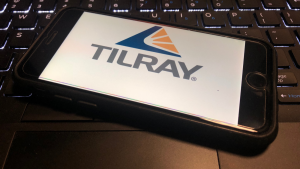3 Beaten-Down Stocks Due for a Massive Short Squeeze
Recently released macro economic data is indicating that the United States economy is heading for a “soft landing.” Specifically, according to the Department of Labor’s Job Openings and Labor Turnover Survey (JOLTS) for July, “2.3% of nonfarm payroll workers quit their jobs” last month, versus the high of 35 during the “Great Resignation.” The “soft-landing” scenario is exactly what large investors with net long positions want because it will allow corporate profits to remain healthy while pushing down inflation and enabling the Fed to cut rates going forward. This is leading to stocks having short-squeeze potential.
As I noted in a recent, past column, Fed Chairman Jerome Powell left the door wide open recently for rate cutting. This is true even if inflation remains above the Fed’s official 2% target. So, the emerging “soft landing” scenario is very bullish for U.S. stocks and should push equities higher. The latter outcome, in turn, should result in many highly shorted stocks undergoing massive “short squeezes.” Here are three stocks with short-squeeze potential.
Groupon (GRPN)

According to fintel.io, 40.6% of the trading volume of Groupon (NASDAQ: GRPN) stock on Aug. 29 involved short sales. Further, 32% of the company’s shares were being sold short as of Aug 15.
Groupon’s recently reported second-quarter financial results improved a great deal compared with its Q1 performance. Specifically, its top line climbed to $129.1 million from $121.6 million. Its operating loss dropped to $5.6 million from $21.8 million and it generated EBITDA of $7.7 million, versus an EBITDA loss of $7.3 million.
The rapid improvement indicates that the changes being implemented by the company’s interim CEO, Dusan Senkypl, are enabling it to convince many more consumers to buy groupons. It will also help to reduce its costs.
Moreover, given the fact that inflation remains fairly elevated, particularly in some categories, GRPN should be able to attract many consumers who are looking for heavy discounts.
The company’s multiple, positive catalysts and high short interest give it great short-squeeze potential.
Brinker International (EAT)

Brinker International (NYSE:EAT), which owns the Chili’s and Maggiano’s restaurant chains, has an elevated Short Squeeze Score of 70.95 from fintel.io. This ranks it 933 out of 4,490 stocks that received the metric.
On Aug. 26, 61.44% of the overall trading volume of EAT stock involved short sales. Meanwhile, a rather high 11.3% of its shares are being sold short, according to Marketwatch.
On Aug. 16, Brinker reported very strong fiscal Q4 results as its comparable sales jumped 6.6% versus the same period a year earlier. Its EBITDA, excluding certain items, climbed to $114.5 million from $100.2 million in Q2 of 2022.
Going forward, I expect the financial results of American restaurant chains to generally remain strong, driven by continued real income gains for U.S. workers and the excellent labor market.
Also noteworthy is that Brinker has a very low forward price-earnings ratio of 9.5.
Tilray (TLRY)

Fintel.io reported that 57.4% of the trading volume of Tilray (NASDAQ: TLRY) stock on Aug. 30 involved short sales. Further, 13.7% of the company’s shares were being sold short as of Aug 15.
On Aug. 30, Bloomberg reported that the Department of Health and Human Services of the Biden administration recommended that cannabis be reclassified “as a Schedule III drug, or a substance considered to have ‘moderate to low potential for physical and psychological dependence’.” Currently, marijuana is a Schedule 1 substance, meaning that it has “no currently accepted medical use and a high potential for abuse.”
According to CNBC, such a change could increase the demand for cannabis and result in Washington easing other restrictions on the cannabis sector.
In a recent column on TLRY and two of its peers, I theorized that Congress seemed much closer than previously to legalizing cannabis.
With Washington apparently poised to greatly ease restrictions on the sector, a short squeeze could easily be ignited in TLRY stock and its peers.
Also importantly, as I pointed out in my previous column, Tilray has made a couple of moves lately which should make its brand significantly more powerful.
On the date of publication, Larry Ramer did not hold (either directly or indirectly) any positions in the securities mentioned in this article. The opinions expressed in this article are those of the writer, subject to the InvestorPlace.com Publishing Guidelines.

